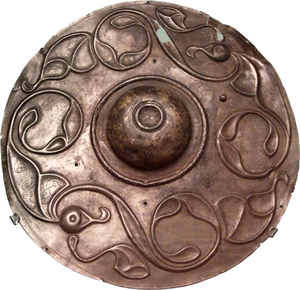Difference between revisions of "Bronze"
| Line 18: | Line 18: | ||
: [[Bronze]] is resistant to [[corrosion]] | : [[Bronze]] is resistant to [[corrosion]] | ||
: [[Bronze]] is harder than [[Copper]]. | : [[Bronze]] is harder than [[Copper]]. | ||
| + | |||
| + | ===References=== | ||
| + | ====AQA==== | ||
| + | :[https://www.amazon.co.uk/gp/product/0198359381/ref=as_li_tl?ie=UTF8&camp=1634&creative=6738&creativeASIN=0198359381&linkCode=as2&tag=nrjc-21&linkId=47c8d1ae58d8b3a5e2094cd447154558 ''Bronze, page 222, GCSE Chemistry; Third Edition, Oxford University Press, AQA ''] | ||
| + | :[https://www.amazon.co.uk/gp/product/1782945962/ref=as_li_tl?ie=UTF8&camp=1634&creative=6738&creativeASIN=1782945962&linkCode=as2&tag=nrjc-21&linkId=476bb5c8d1dfb5c08ac81b6d4d1c98d8 ''Bronze, page 285, GCSE Chemistry, CGP, AQA ''] | ||
Revision as of 12:15, 28 October 2019
Contents
Key Stage 2
Meaning

A picture of a Bronze shield.
Key Stage 3
Meaning
Bronze is an alloy made of around 88% Copper and 12% Tin.
About Bronze
- Bronze was one of the first alloys ever made as it could be easily shaped into swords and shields but was harder than pure Copper.
Key Stage 4
Meaning
Bronze is an alloy made of around 88% Copper and 12% Tin.